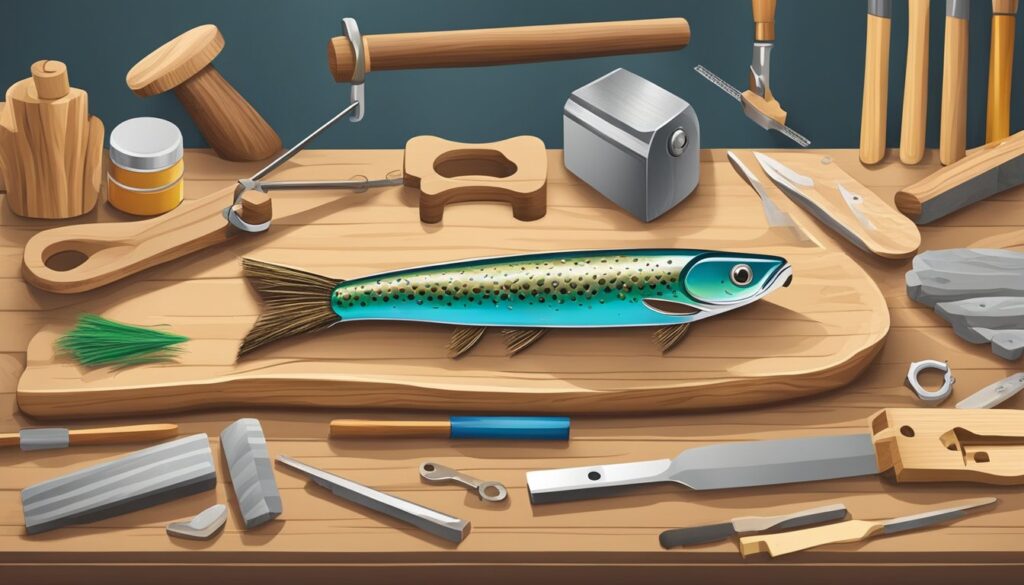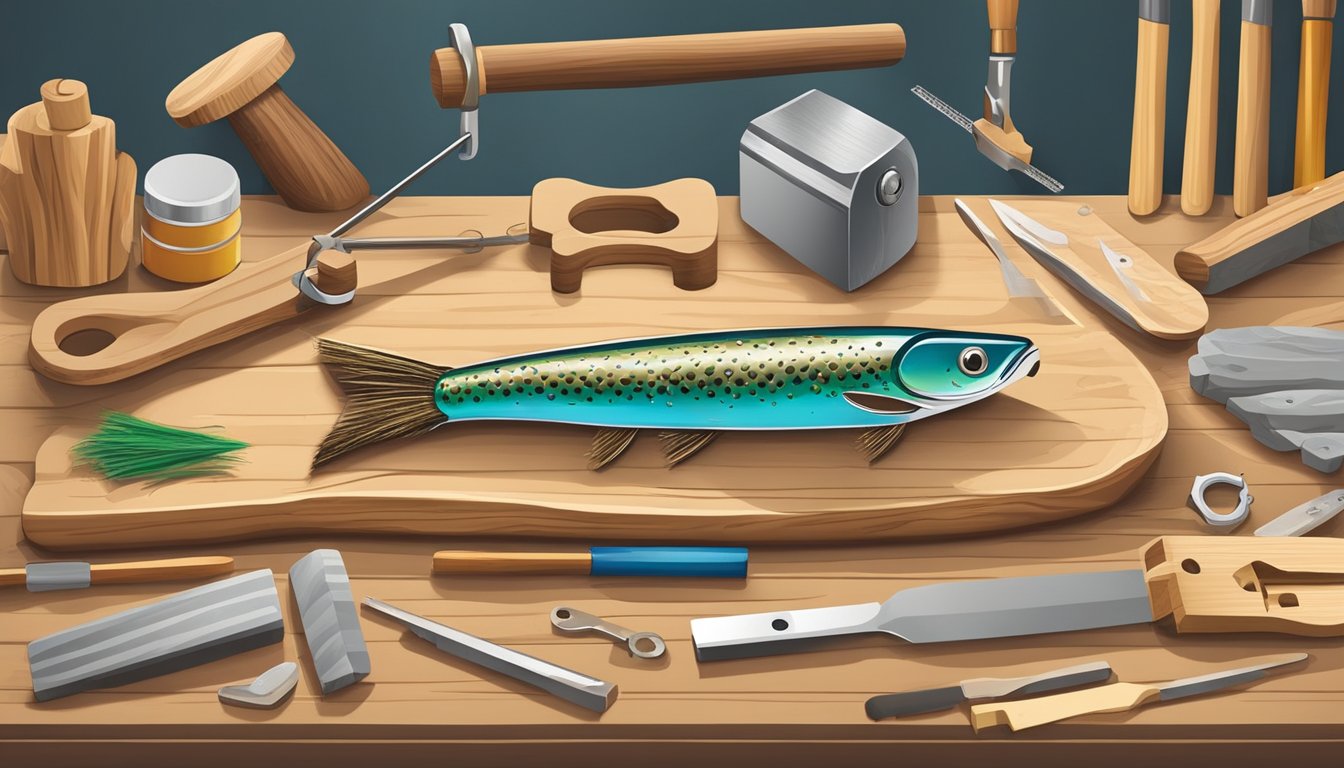How to Make Fishing Lures Out of Wood
If you’re an avid fisherman, you know that having the right lure can make all the difference in your success on the water. While there are plenty of options on the market, there’s something special about how to make fishing lures out of wood. Not only is it a fun and rewarding hobby, but it also allows you to create a truly unique lure that’s tailored to the fish you’re trying to catch.

To get started, you’ll need to select the right type of wood for your lure. Not all woods are created equal, and some are better suited for fishing lures than others. Once you’ve chosen your wood, you’ll need to design your lure and decide on the shape, size, and weight. From there, you’ll use carving techniques to shape and refine your lure, and add hardware attachments to bring it all together.
Whether you’re an experienced woodworker or a beginner looking to try something new, making your own fishing lure out of wood can be a fun and rewarding experience. With a little bit of patience and practice, you’ll be able to craft a lure that’s not only functional but also a work of art.
Essentials of Wood Selection

When making fishing lures out of wood, choosing the right type of wood is essential. The type of wood you choose will affect the durability, buoyancy, and overall effectiveness of your lure. In this section, we will discuss the types of wood that are commonly used for making fishing lures, as well as the factors you should consider when selecting the right wood.
Types of Wood for Lures
Several types of wood are commonly used for making fishing lures, including balsa, cedar, basswood, and pine. Balsa is a popular choice due to its lightweight and buoyancy, while cedar and basswood are known for their durability and ability to hold paint well. Pine is a less expensive option but is not as durable as other types of wood.
When selecting the type of wood for your lure, consider the type of fish you will be targeting, as well as the water conditions you will be fishing in. For example, if you are fishing in saltwater, you may want to choose a more durable wood such as cedar or basswood.
Wood Hardness and Durability
The hardness and durability of the wood you choose will also affect the effectiveness of your lure. Harder woods such as maple and oak are less likely to break or chip, but may not be as buoyant as softer woods like balsa. Softer woods are more buoyant but may not hold up as well over time.
When selecting the wood for your lure, consider the hardness and durability of the wood, as well as its buoyancy. You may need to experiment with different types of wood to find the right combination of buoyancy and durability for your specific fishing needs.
Overall, selecting the right type of wood is essential when making fishing lures. Consider the type of fish you will be targeting, as well as the water conditions you will be fishing in, when selecting the type of wood. Also, consider the hardness and durability of the wood, as well as its buoyancy, to ensure that your lure is effective and long-lasting.
Designing Your Lure

When it comes to designing your wooden fishing lure, there are a few important factors to consider. In this section, we’ll explore two key areas: shape and size considerations, and balance and buoyancy factors.
Shape and Size Considerations
The shape and size of your lure can have a big impact on its effectiveness. Here are a few things to keep in mind:
- Choose a shape that mimics the natural prey of the fish you’re targeting. For example, if you’re fishing for bass, a lure shaped like a frog or a small fish might be effective.
- Consider the size of the fish you’re targeting. A larger lure might be more effective for larger fish, while a smaller lure might be better for smaller fish.
- Think about the water conditions you’ll be fishing in. A heavier, more streamlined lure might be better for deeper water, while a lighter, more buoyant lure might be better for shallow water.
Balance and Buoyancy Factors
The balance and buoyancy of your lure can also play a big role in its effectiveness. Here are a few things to consider:
- Make sure your lure is properly balanced. If it’s too heavy on one side, it might not swim properly in the water.
- Consider the buoyancy of your lure. A lure that sinks too quickly might not be effective, while a lure that floats too much might not be able to dive deep enough to attract fish.
- Experiment with different materials and weights to find the right balance and buoyancy for your lure.
By taking these factors into account, you can design a wooden fishing lure that is both effective and enjoyable to use.
Carving Techniques

Hand Carving Basics
When it comes to carving fishing lures out of wood, hand carving is a great option for those who don’t have access to power tools or prefer a more traditional approach. To get started, you’ll need a few basic tools such as a carving knife, chisels, and gouges. It’s important to practice good carving techniques to ensure your lures turn out the way you want them to.
First, make sure your tools are sharp and well-maintained. Dull tools can be dangerous and can also make carving more difficult. Next, start with a rough block of wood and use your carving knife to create a basic shape. From there, use your chisels and gouges to add details and refine the shape. Remember to work slowly and carefully, making small cuts and checking your progress frequently.
Using Power Tools Safely
Power tools can make carving fishing lures out of wood faster and easier, but it’s important to use them safely. Always wear eye and ear protection when using power tools, and make sure you read and follow the manufacturer’s instructions carefully.
When using a power carving tool such as a rotary tool or angle grinder, start with a rough block of wood and use a coarse grit sanding attachment to shape the lure. From there, switch to finer grit attachments to refine the shape and add details. Remember to work slowly and carefully, making small cuts and checking your progress frequently.
Overall, whether you choose to hand carve or use power tools, carving fishing lures out of wood can be a rewarding and enjoyable hobby. With practice and patience, you can create beautiful and functional lures that will help you catch more fish.
Finishing Touches

After shaping and carving your wooden fishing lure, it’s time to add the finishing touches that will make it truly unique. The following subsections will cover the two most important steps in finishing your wooden lure: sanding and smoothing, and painting and sealing.
Sanding and Smoothing
Sanding and smoothing your wooden lure is an essential step in creating a polished, professional look. Start by using coarse-grit sandpaper to remove any rough spots or bumps on the surface. Then, gradually work your way up to a finer grit sandpaper, until the surface is completely smooth.
To ensure that your lure is perfectly smooth, you can use a wood filler to fill in any cracks or imperfections. Once the wood filler has dried, sand it down until it’s flush with the rest of the surface.
Painting and Sealing
Once your wooden lure is smooth and polished, it’s time to add some color and protection. Start by applying a coat of primer to the surface, which will help the paint adhere better.
Next, choose a high-quality paint that is specifically designed for use on wooden surfaces. Apply the paint in thin, even layers, allowing each layer to dry completely before applying the next.
Finally, add a layer of clear sealant to protect the paint and give your lure a glossy finish. Be sure to follow the manufacturer’s instructions for applying the sealant, and allow it to dry completely before using your lure.
By following these simple steps, you can create a beautiful, handmade wooden fishing lure that is sure to attract plenty of fish.
Hardware Attachment

Choosing Hooks and Rings
When it comes to choosing the right hooks and rings for your wooden fishing lures, there are a few factors to consider. First, think about the type of fish you are targeting and the size of the lure you are making. You’ll want to choose hooks and rings that are strong enough to handle the weight of the lure and the force of the fish, but not so large that they overpower the lure’s appearance.
Another important factor to consider is the material of the hooks and rings. Stainless steel is a popular choice for its durability and resistance to rust, but other materials such as nickel or brass can also work well. Be sure to choose hooks and rings that are appropriate for the type of water you’ll be fishing in, as saltwater environments can be particularly harsh on metal components.
Secure Attachment Methods
Once you’ve chosen your hooks and rings, it’s time to attach them to your wooden lure. There are a few secure attachment methods you can use, depending on the design of your lure and the materials you have available.
One common method is to drill a small hole through the top of the lure and attach the hook with a split ring. This allows the hook to move freely and gives the lure a more natural swimming motion in the water. Another option is to screw an eyelet into the top of the lure and attach the hook directly to the eyelet with a split ring.
For larger lures or heavier fish, it may be necessary to use wire or screw eyes to attach the hooks. These methods provide a more secure attachment point and can handle greater weight and force. Whichever method you choose, be sure to test the strength of the attachment before using the lure in the water to ensure it can handle the force of a fish.
Testing and Refinement
After you have finished making your wooden fishing lure, it is time to test and refine it to ensure optimal performance.
Water Testing Your Lure
Before you take your wooden fishing lure out on the water, it is important to test it in a controlled environment. Fill a small container with water and place your lure in it. Observe how it moves and behaves in the water. Does it float? Does it sink? Does it move in a natural way? If your lure is not behaving as expected, you may need to make some adjustments.
Adjustments for Performance
If your wooden fishing lure is not performing as well as you would like, there are several adjustments you can make to improve its performance. Here are some common adjustments:
- Adjust the weight: If your lure is sinking too quickly, you may need to remove some weight. If it is not sinking at all, you may need to add some weight.
- Adjust the shape: If your lure is not moving in a natural way, you may need to adjust its shape. Try sanding it down or adding some additional features to make it more realistic.
- Adjust the hooks: If you are not getting any bites, you may need to adjust the hooks on your lure. Make sure they are sharp and positioned in the right place.
By testing and refining your wooden fishing lure, you can ensure that it performs optimally and increases your chances of catching fish.


